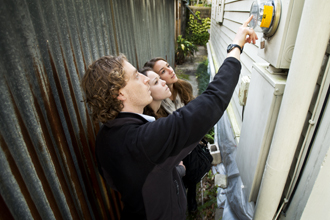Audits show uneven energy use in similar 'green' buildings
Since Hurricane Katrina, New Orleans has had an opportunity to rebuild with an emphasis on energy-efficient homes. But how “green” are the new buildings? Tulane 2012 architecture grad Corey Squire is leading a class of architecture students to survey area homes to gather data on energy usage and comfort.

Architecture students, led by recent grad Corey Squire, evaluate the uptown home of John Klingman to see how “green” it is. (Photo by Ryan Rivet)
Squire, a 2012â“13 research fellow with the Eskew+Dumez+Ripple architecture firm, is working with Z Smith, director of building performance and sustainability for the firm. Smith is teaching the School of Architecture course Building, Climate and Comfort.
A $13,000 grant from the National Council of Architectural Registration Boards provided the students with data-logging equipment such as occupancy sensors that count people in areas of the buildings over time.
Among the buildings studied during the fall semester were two Global Green USA houses and one Make It Right home.
The research is producing results that Squire has found “surprising and interesting,” he says.
“There is a huge amount of variation in energy usage depending upon how the occupants use the space. It can amount to a two to three times difference, in houses that are identical.” Thus, for houses to be the most sustainable, Squire says, occupant education is key. “A whole roof of solar panels alone is not enough.”
Because New Orleans has a notoriously hot and humid climate, the research results may guide architectural design of structures in areas around the world with a similar climate, where the majority of the world's building boom is taking place.
“Our ultimate goal [as architects] is to provide the most comfort for occupants with the least use of resources,” Squire says.
